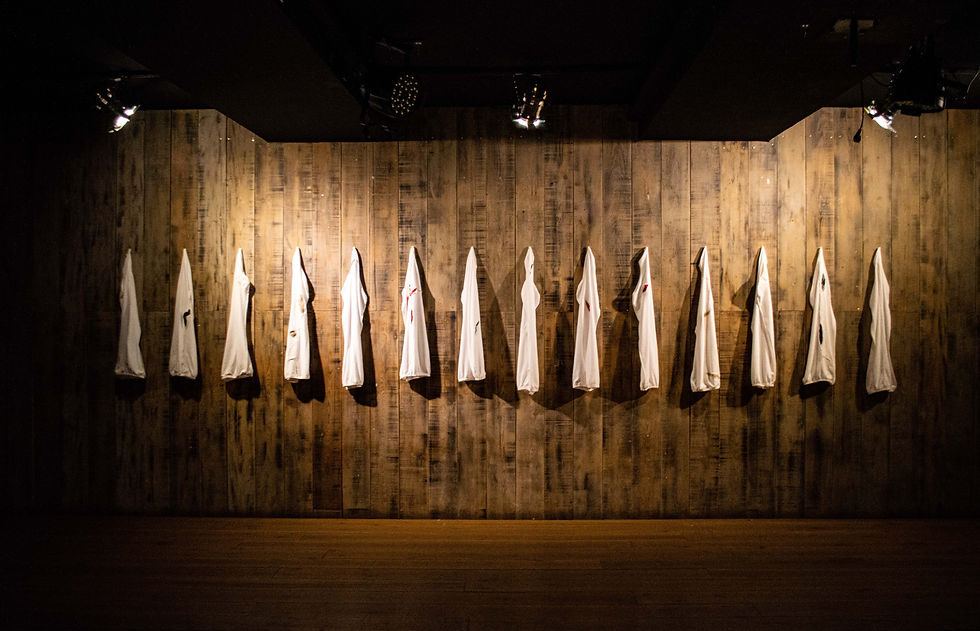
romina
rivero
I deserve 2024/2025
Individual_MODUS OPERANDI GALLERY
With the collaboration of Gobierno de Canarias
To understand where I stand — in my life and in history —
as a human being,
as a woman,
as a European citizen of a colony with enslaved ancestors,
as the granddaughter of survivors of the Francoist holocaust,
as the daughter of a couple raised in fear and repression, from whom
their small piece of land was taken and whose natural resources were privatised — the few that still remain.
As an artist, a doctor of acupuncture.
Recently, as a mother.
I have come to understand that those of us who are here, were there.
And that all those wounds are also mine...
I deserve — and desire — through a lifelong commitment and as a collective legacy,
to heal.
Romina Rivero
A creative process spanning a decade, the initial stage of the artist's career, which she now declares complete — giving way to the birth of another.
"For Romina Rivero, the vertebra is a symbol of vulnerability and, at the same time, of pure liberating power. The bones in her work stem from a personal experience linked to both physical and spiritual healing. They embody the struggle from within, understanding the body as an extension of the inner self, capable of overcoming the external domains that subjugate and constrain it. The threads reveal the possibility of physical repair, while at the same time representing the internal and external tensions between the individual body and the one institutionally constructed through systems of power and vital control. Rivero’s work expands towards a global reflection on the pain of bodies, their ability to regenerate, and their contemplation of their scars, their beauty, and their multiplicity.
The exhibition brings together a selection of multidisciplinary pieces, from 2017 to the present day, which convey the artist’s concerns through anatomical fragments marked by diverse wounds: the wound of grief, buried during the pandemic yet so present today with the DANA; the wound of labour, filled with endless hours in which individuals become machines; the wound of war, formed by hundreds of victims who have championed and still champion the struggle; the wound of gender, full of women who have suffered and continue to suffer injustice, persecution, and the curtailment of their rights and freedoms; the wound of religion, the origin of Christian guilt and a tool for the manipulation of thought; the wound of health, inflicted through deceit, medical corruption, and the control exerted by pharmaceutical companies."
Nerea Ubieto
curator, cultural manager, and art critic
Projecting the wound: Ritual, community and memory
"It becomes imperative to reopen a wound if there are signs of infection or if the healing has been faulty, as this may lead to chronic pain or reduced mobility. Likewise, if a wound closed with foreign bodies trapped inside, it must be reopened to extract them.
Could shared wounds exist? Personally, I believe they do — increasingly so — and that they are not necessarily shared through proximity. I also believe we do not quite know where these wounds reside, though we know they hurt, or at least trouble us and hinder our freedom of movement.
If we don’t know exactly where these wounds lie, how do we know where to cut to begin healing? We sense, we perceive, foreign bodies — alien — with which we long to form a closer connection, to undo the sense of otherness, to locate the wound and intervene appropriately. Yet those bodies have long been trapped beneath the suture of a poorly treated wound.
The alternative lies in developing a kind of spectral diagnosis — deepening our ability to explore the invisible, to perceive the resonances that remain trapped, to converse with ghosts, with the non-living, in order to bring into the present the traumas of the past that still ache, deep within wounds cauterised with lead, whose toxic aftermath complicates the possibility of healing today.
The spectral demands inhabiting a dislocated time — one that flows and intertwines past and present freely — transcending the imposed logic of linear time, and warning us that what seems distant may, in fact, be far closer than we think." (...)
Eduardo Caballero
curator and cultural manager
https://artizar.es/en/exhibition/gen-80/
(complete texts)




























